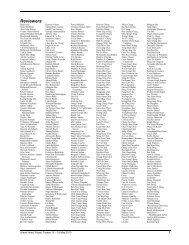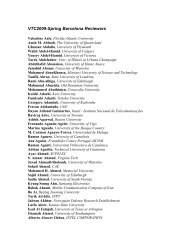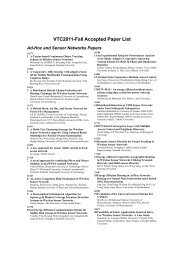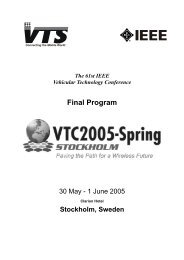Final Programme 2 â 5 June 2013 Dresden, Germany - ieeevtc.org
Final Programme 2 â 5 June 2013 Dresden, Germany - ieeevtc.org
Final Programme 2 â 5 June 2013 Dresden, Germany - ieeevtc.org
Create successful ePaper yourself
Turn your PDF publications into a flip-book with our unique Google optimized e-Paper software.
CAR Communication Consortium (vice chairman of the WG<br />
COM) and to ITS standardization in ETSI Specialist Task<br />
Forces. He was Co-Chair of the Track Transportation,<br />
Vehicular Networks, and Vehicular Electronics and Telematics<br />
of the IEEE VTC<strong>2013</strong>-Spring, and TPC Co-Chair of the IEEE<br />
International Symposium on Wireless Vehicular<br />
Communications (IEEE WiVEC) 2010. He holds a M.Sc.<br />
degree and a Dr. ès sc. degree in telecommunication from the<br />
Swiss Institute of Technology (EPFL), Lausanne, Switzerland.<br />
Mikael Nilsson received his B.Sc. degree in Electrical<br />
Engineering – Radio electronics at Växjö University in 1997.<br />
From 1997 through 2003 he worked mostly as consultant<br />
within telecom and space industry within different areas such<br />
as simulation and design of waveguide diplexers, development<br />
of hat-fed reflector antennas and testing satellite receivers.<br />
In 2003 Mikael Nilsson joined Volvo Cars as RF engineer<br />
for antennas and transceivers in the area of Remote Keyless<br />
Entry. He was awarded the Ford Motor Company European<br />
Technical Achievement Award in 2006 for the Personal Car<br />
Communicator and in 2008 Mikael Nilsson was certified as a<br />
Black Belt according to Six Sigma methodology. From 2008-<br />
2011, he worked in the infotainment area as Attribute Leader<br />
for Wireless Connectivity. Since 2011 Mikael Nilsson hold the<br />
position as industrial Ph.D. student enrolled at Lund<br />
University, department of Electrical and Information<br />
Technology, and his principle research areas are channel<br />
characterization of the 5.9GHz band and measurement systems,<br />
namely the multipath propagation simulator. Also since 2012<br />
Mikael Nilsson holds the position as Technical Expert –<br />
Wireless Communication within Volvo Cars.<br />
He is a member of IEEE, Car-2-Car Communication<br />
Consortium, CHASE Assembly (VINN Excellence Centre at<br />
Chalmers). Mikael Nilsson is dedicated to the Six Sigma<br />
methodology and has teaching several Design for Six Sigma<br />
and Green Belt courses within Volvo Cars.<br />
Javier Gozalvez received an electronics engineering degree<br />
from the Engineering School ENSEIRB (Bordeaux, France),<br />
and a PhD in mobile communications from the University of<br />
Strathclyde, Glasgow, U.K. Since October 2002, he is with the<br />
University Miguel Hernandez of Elche, Spain, where he is<br />
currently an Associate Professor and Director of the<br />
UWICORE (Ubiquitous Wireless Communications Research,<br />
www.uwicore.umh.es) Laboratory, and Deputy Vice-President<br />
for International Relations. At UWICORE, he is leading<br />
research activities in the areas of wireless vehicular<br />
communications, multi-hop cellular networks, radio resource<br />
management, heterogeneous wireless systems, and wireless<br />
system design and optimization. He currently serves as Mobile<br />
Radio Senior Editor of IEEE Vehicular Technology Magazine,<br />
and previously served as AE of IEEE Communication Letters.<br />
He was General Co-Chair for the Ninth ACM International<br />
Workshop on VehiculAr Inter-NETworking, Systems, and<br />
Applications (ACM VANET 2012), TPC Co-Chair of the 2011<br />
IEEE Vehicular Technology Conference-Fall, TPC Co-Chair<br />
of the 2009 IEEE Vehicular Technology Conference-Spring,<br />
and General Co-Chair of the 3rd ISWCS 2006. He is also the<br />
founder and General Co-Chair of the IEEE International<br />
Symposium on Wireless Vehicular communications (WiVeC)<br />
in its 2007, 2008, and 2010 editions. He has been elected to the<br />
Board of Governors of the IEEE Vehicular Technology Society<br />
(2011–<strong>2013</strong>), and to the IEEE Distinguished Lecturers program<br />
of the IEEE Vehicular Technology Society.<br />
Dr. Marc Werner obtained the Diploma and Ph.D. (Dr.)<br />
degrees in Communications Engineering from RWTH Aachen<br />
University, <strong>Germany</strong>. Since 2006, he is with Qualcomm’s<br />
R&D department in Nuremberg, <strong>Germany</strong>, where he has<br />
worked in several public research projects towards new radio<br />
technologies for LTE-Advanced and beyond, as well as in<br />
different related standardization and regulatory groups. Apart<br />
from leading the technical modem development work for the<br />
upcoming vehicular emergency call system, eCall, he has been<br />
involved in performance studies of wireless vehicle-to-vehicle<br />
communication links on MAC and PHY layers, and in ETSI’s<br />
Intelligent Transport Systems (ITS) standardization group.<br />
Tuesday 04 <strong>June</strong> <strong>2013</strong>, 15:30–17:00 (Saal 1+2)<br />
Innovative Vehicular Applications – A European Perspective<br />
Chair: J<strong>org</strong>e Pereira, Principal Scientific Officer at European Commission<br />
Panelists: João Barros, Asscociate Professor at University of Porto, Portugal<br />
Manuel Serrano Matoses, Head of New Technologies at ETRA I+D, Spain<br />
Stefan Viehmann, Senior VP Global Customer Solutions at Kuehne + Nagel Management<br />
AG, <strong>Germany</strong><br />
Pedro José Marrón, Professor at University Duisburg-Essen, <strong>Germany</strong><br />
The scope of Vehicular Applications is as broad as the VT Society itself, and even in the most traditional<br />
domains innovative applications are being developed, and more importantly, deployed in large-scale in the<br />
real-world. The Panel will provide a European perspective of the area, including some less conventional<br />
applications which rely on truly inter-disciplinary approaches.<br />
Dr. J<strong>org</strong>e M. Pereira obtained the Engineering and M.Sc.<br />
degrees in Electrical and Computer Engineering from Instituto<br />
Superior Técnico (IST), Lisbon, Portugal in 1983 and 1987,<br />
respectively; he received the Ph.D. in Electrical Engineering-<br />
Systems from the University of Southern California, Los<br />
Angeles, in 1993.<br />
Between 1983 and 1988, he taught in the Department of<br />
Electrical and Computer Engineering of IST as Full Lecturer in<br />
the areas of Eletrotechnics and Electrical Measurements,<br />
Applied Electronics and Telecommunication Systems, and in<br />
1994 became Assistant Professor. He is on leave of absence<br />
from IST.<br />
From 1988 to 1990, he worked at LinCom Corp., Los<br />
Angeles, in a NASA project on space-to-space<br />
communications, and on synchronization issues. From 1991 to<br />
1993, he worked for Caltrans (California Department of<br />
Transportation) and PATH (Partners for Advanced<br />
Transportation TecHnology) on Intelligent Vehicle Highway<br />
Systems (IVHS). From 1993 to 1996, at GTE Laboratories<br />
Inc., Waltham, MA, he was responsible for Communication<br />
Analysis and Simulation in the National IVHS Architecture<br />
Federal Highway Administration contract, and represented<br />
GTE at the Telecommunications Industry Association (TIA)<br />
IVHS Section, and in the High Speed Data Systems workgroup<br />
of the CDMA Development Group. At the same time, he was<br />
involved in the first wireless data (CDPD) trials in the San<br />
Francisco Bay Area, involving location-based applications.<br />
MARITIM Hotel & Internationales Congress Center <strong>Dresden</strong> 2-5 <strong>June</strong> <strong>2013</strong> 23







